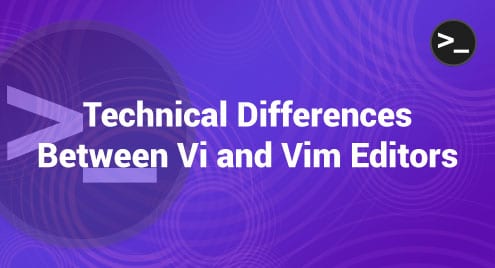Whenever you are using any operating system and you frequently wish to work with files, the very first thing that you should consider is to choose a good editor. As far as the Linux or Unix operating systems are concerned, the two most commonly heard names of text/source code editors are Vi and Vim. In this article, we will try to explore both of these editors in terms of their technical differences.
The Vi Editor
Vi stands for “Visual Editor” and is a very minimalistic yet useful editor that comes by default with most of the Linux distributions. It can be used for text as well as source code editing. However, the feature set provided by this editor is very limited.
The Vim Editor
Vim stands for “Vi Improved” and is an advanced and better variant of the traditional Vi editor. Its capabilities span a large number of different features that make it more powerful than the default Linux editor, Vi.
Technical Differences between Vi and Vim Editors
The technical differences between the Vi and Vim editors are discussed in the following points:
1. Advanced Features
Since Vim is an upgraded version of the Vi editor, therefore, it offers more advanced features related to text and code editing that makes the Vim editor all the more versatile.
2. The Undoing Ability
The Vim editor allows you to undo your text as many times as you wish whereas the Vi editor lacks this capability.
3. Text Highlighting
Vim has a very fascinating text highlighting ability that enables you to beautify the appearance of your text as well as distinguish the different sections of your text. While the Vi editor does not support this feature.
4. Graphical User Interface (GUI)
Vim editor also has its dedicated GUI which makes it all the easier to use it whereas the Vi editor does not have its own GUI.
5. Storage Requirements
Because of the large number of advanced features offered by the Vim editor, it consumes more storage resources. On the other hand, Vi is a very lightweight text editor because of which its mostly preferred by users with resource constraints.
6. Screen Splitting
Vim editor allows you to split your screen into multiple sub-screens so that you can perform different tasks simultaneously. You cannot do this while using the Vi editor.
7. Compatibility and Support
Although Vim is an advanced version of the Vi editor, it can still downgrade itself to act as the Vi editor. Contrary to this, the Vi editor is not compatible with the advanced features of the Vim editor as it includes no support for those features. Moreover, the Vim editor can be installed on most of the operating systems even other than Linux whereas the Vi editor can only be used with the Linux or Unix based systems.
Conclusion
With this, we come to the end of this informative article. However, you might be wondering now which, out of Vi and Vim, should you choose to use on your Linux system. Well, if you only wish to edit the basic files and you also have limited resources, you will be good to go with the Vi editor. However, if you wish to experience more complex and advanced features and are also not short on computing resources, you are advised to use the Vim editor.




